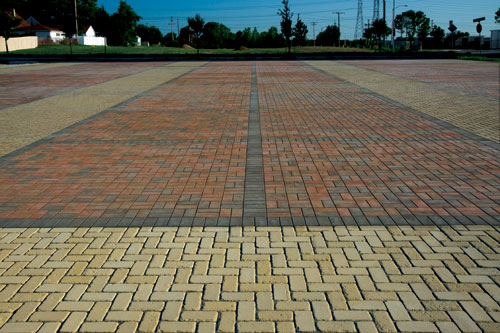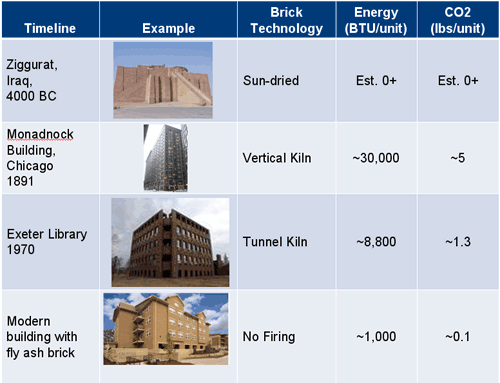Reducing Embodied Energy in Masonry Construction
LEED & Beyond – Designing with Fly Ash Brick
The U.S. Green Building Council considers fly ash to be a post-industrial recycled material, which can contribute to LEED points for recycled materials (Credit MR 4 under LEED 2009). This is just one way in which fly ash unit masonry can contribute to green and sustainable buildings. Other ways include the following:
- Sustainable Sites: (See Figure 6)
- Alternative Transportation – Public Transportation Access: Fly ash pavers can be used effectively for biking or pedestrian paths between buildings and transit stops.
- Stormwater Design – Quantity and Quality Control: If used in pervious paving areas, fly ash pavers can contribute to an effective stormwater design solution helping to control both the quantity and quality of that stormwater.
- Heat Island Effect – Non-roof /cool paving: High-reflectance fly ash pavers or open-grid pavement will perform quite well as an alternative to dark, heat absorbing pavement.
- Heat Island Effect – covered parking: If used on the roof of a covered parking structure, fly ash pavers that are reflective will reduce the heat island effect.
- Water Efficiency:
- Water-Efficient Landscaping: If used as part of a pervious paving area, fly ash pavers can be used in the overall landscaping plan and its corresponding water efficiency.
- Energy and Atmosphere:
- Optimize Energy Performance: The thermal mass of fly ash bricks can be used to help control temperature fluctuations and truly optimize building envelope performance.
- Materials and Resources:
- Recycled Content: Fly ash masonry products typically contain 40% post-industrial recycled content.
- Regional Materials: For sites within 500 miles of factories, fly ash bricks and pavers help reduce the energy used in transporting materials.
- Indoor Environmental Quality:
- Thermal Comfort – Design: The thermal mass of fly ash bricks can help maintain comfortable interior temperatures with fewer fluctuations.
- Enhanced Acoustical Performance, Schools: Brick can help reduce transmission of background noise into core learning spaces due to its high density as a material.
- Innovation:
- Other possibilities for innovative uses of fly ash brick in buildings exist particularly related to life cycle improvements. For example, fly ash is often used to replace part of the Portland cement in concrete, which reduces the overall lifecycle impacts of concrete, by reducing the associated embodied energy and CO2. A similar case could be made for fly ash brick replacing clay brick and reducing the overall embodied energy and CO2 of the brick.
 |
FIGURE 6: Fly ash pavers can contribute to a variety of sustainable site initiatives in addition to other energy and environmental benefits. Image courtesy of CalStar Products, Inc. |
Beyond building construction and operations, using a comprehensive design strategy to incorporate materials with reduced embodied energy and carbon footprints is clearly the way to reduce the impact of building materials on the environment, as well as achieve the goals of other programs such as the Architecture 2030 Challenge for Building Products.
Conclusion – Sustainable Bricks of the Past, Present, and Future
If we look at a timeline from the beginnings of brick masonry through the present, it is interesting to note that we might be coming full circle. (See Figure 7) The Ziggurat in Iraq, built in 4000 BC, was constructed of sun-dried brick that required no kiln firing thus consuming no fuel and creating no CO2 emissions, yet produced a brick durable enough to last through to present times. The Monadnock building, built in Chicago in the late 1800's, used 6-foot thick solid masonry walls at the base. Highly inefficient vertical brick kilns consumed massive amounts of fuel, about 30,000 BTUs per brick, and consequently emitted large quantities of greenhouse gas emissions in the process. The Exeter Library in New Hampshire designed by Louis Kahn and built around 1970 benefited from some improvements in clay brick making, which lowered the fuel consumed in firing down to about 8,800 BTUs per brick, or the typical range of current tunnel style brick kilns. If we look at current projects, it is possible that if new fly ash brick making technology were used, the fuel consumption and greenhouse gas emissions could be reduced to levels closer to the construction of the Ziggurat. Through this innovative thinking and fly ash-based technology, brick masonry really can come full circle to provide timeless character while offering the sustainability qualities that our planet demands.
 |
FIGURE 7: The historical progression of brick technology and the resulting energy and CO2 emissions. Image courtesy of CalStar Products, Inc. |
| ENDNOTES | |
| 1 | Energy Information Administration, 2011 |
| 2 | Energy Information Administration |
| 3 | “Potential Carbon Emissions Reductions In the Building Sector by 2030”, Brown, Stovall & Hughes, Oak Ridge National Lab |
| 4 | www.Architecture2030.org |
| 5 | Energy Information Administration Annual Energy Output (AEO) 2005, 2007, 2009, 2011 |
| 6 | See Architecture 2030 |
| 7 | NAHB, 2004 Housing Facts, Figures and Trends, Feb. 2004, p. 7 |
| 8 | NIST’s BEES 4.0 database reports 8800 BTU per modular brick equivalent. The BIA reports 1240 BTU/lb or 5200 BTU per modular brick equivalent. A middle figure of 6000 BTU per modular brick equivalent was chosen for these calculations. |
| 9 | Architecture 2030; Data Source US Energy Information Administration |
| 10 | Ibid viii |
| 11 | ACAA annual production surveys |
| 12 | Frances Beinecke, President of National Resources Defense Council, CLEAN ENERGY, COMMON SENSE; Chapter 5 |
 |
CalStar Products has reinvented masonry to make it more sustainable and more affordable. Our masonry products represent a significant improvement in environmental performance over fired clay and concrete products including 40% recycled content, 85% smaller carbon footprint and up to 85% less embodied energy. www.calstarproducts.com |








